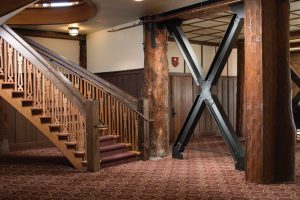The Great Northern Railway built the Many Glacier Hotel from 1914 to 1917. This iconic hotel, built in the style of a Swiss chalet, is perched on the edge of Swiftcurrent Lake overlooking the glaciated valleys and mountains of Glacier National Park’s less-traveled east side. The Many Glacier Hotel was listed on the National Register of Historic Places in 1976 and was designated as a National Historic Landmark in 1987. However, due to significant deficiencies in the knob-and-tube wiring, the plumbing and fire-suppression systems, and the gravity and lateral load-resisting structural systems, the structure was placed on the National Trust for Historic Preservation’s annual list of “America’s 11 Most Endangered Historic Places” in 1996.
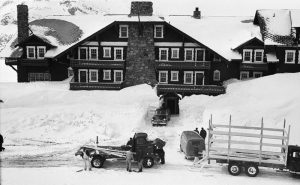
The Many Glacier Hotel in April 1956. Snow has reached the second floor of the lobby. Chimney at left was removed at an unknown date before the recent rehabilitation work. Courtesy of Glacier National Park Archives.
The National Park Service initiated a comprehensive, phased rehabilitation around 2000. The first phases focused on the most immediate needs of the building’s exterior. In 2004, JVA, Inc. was engaged as the structural engineer in partnership with the architect, Anderson Hallas Architects, P.C. The team worked on the rehabilitation for 13 years until its completion in 2017. Swank Enterprises was the general contractor for all the construction phases, which totaled approximately $42 million.
The hotel is situated in an alpine environment, and the structural systems were suffering due to extreme environmental conditions. In winter months, drifted snow can reach the third floor of the hotel, 20 feet above grade on the uphill side, with a design ground snow load of 180 pounds per square foot. The annual onslaught of snowmelt running under the building was undermining the foundations and causing the wood framing at the base of the building to deteriorate.
The approximately 140,000-square-foot hotel is framed with a mix of heavy timber, log, and dimension lumber. The foundations and chimneys are stone masonry. The four-story building with a walkout basement features exterior balconies on all sides and all levels, grand masonry chimneys in the public spaces, a four-story lobby atrium space framed with log columns and trusses, and an expansive dining room with a timber and steel-rod trussed roof. The structural rehabilitation scope involved repairing deteriorated framing, fortifying the roof framing for the 135 psf roof snow load, and retrofitting the building’s lateral system for Seismic Design Category C. The building’s original lateral force-resisting system consisted merely of interior stud walls surfaced with Sacket Board (a more brittle precursor to gypsum wallboard) and exterior walls surfaced with board sheathing. Because the lateral force-resisting system upgrade was voluntary, 75% of current-day code-prescribed seismic forces were used as permitted by the International Existing Building Code. All upgraded and new structural systems had to be concealed within the building’s walls, floors, and chimneys to maintain the visitor experience.
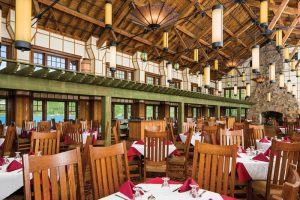
Interior of the dining room featuring the chimney and the original roof trusses. Courtesy of Mark Bryant Photographics.
The roof framing over the dining room had been concealed by a dropped ceiling installed in the 1930s. After selective strengthening of the purlins using lumber that matched the original lumber in appearance, the dropped ceiling was removed. The timber and steel-rod trusses were re-exposed, paying homage to the railroad engineers that designed and built them.
In the guest wings, the partitions between rooms did not align across the central corridors and did not stack perfectly from floor to floor. The partitions on one side of the hallway were mobilized as shear walls so that utilities could be routed on the opposite side. The partitions were reconstructed as shear walls to resist wind and seismic loads in the guest wings’ short direction using their average centerline along the building height. Having a height-to-length aspect ratio of approximately 5:1, the lower stories are concrete and the upper stories are wood. Steel rod holdowns extend continuously from the top of concrete to the attic level, and collectors were installed at each diaphragm level. The shear walls were re-clad with their historic board-and-batten wainscoting. Each shear wall was founded on a new concrete grade beam supported by new micropiles capable of resisting uplift forces over 100 kips. A small rig was driven inside the building to install piles to an approximate depth of 50 feet into the bedrock.
To reduce seismic mass, four utilitarian chimneys that were concealed behind finishes and that historically expelled gases from wood-burning stoves in the guest rooms were removed. One other chimney was removed at an unknown date before the rehabilitation. Five stone masonry chimneys remain: three feature fireplaces for hotel visitors in the dining room, lobby, and lounge areas, one serving deluxe guest rooms at each level, and one serving the kitchen.
The existing chimneys all required reinforcement and positive attachment to the building’s diaphragms. Each chimney was unique and required a different structural solution. Chimney reconstruction was not a viable option because of the desire to preserve the historic fabric and to control costs. Some chimneys were used as shear-resisting elements with new collectors; others were tied into the diaphragms and their mass was resisted by nearby shear walls.
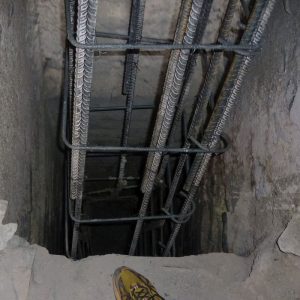
Reinforcing cage inserted into the full-height flue of the dining room chimney. Courtesy of Dan Cooke, JVA, Inc.
The dining room chimney has two flues. The flue that originally served the boiler in the basement was cleaned, reinforced, and grouted. The chimney’s shoulder on the opposing side was removed, a reinforced concrete chord installed, and the shoulder was refaced with the original stones in their original positions. The dining room flue, which follows the reinforced shoulder, remains operational.
The lobby chimney weighs almost 500 kips. Its basement-level flue was internally reinforced and grouted from top to bottom. The outer leaf of stone was pinned to the reinforced core. The lobby-level flue remains operational. The lounge chimney has only one flue and it also needed to stay operational. A 40-foot-tall, 20-inch-diameter, 16-gage steel round form was lowered into the 24-inch square flue via a crane. The spaces between the original square flue and the new steel form were reinforced and grouted. The chimney serving guest rooms on each floor, having 8 flues, is situated at the end of a guest wing. The exterior stud wall concealed its back face. The stud wall was removed, the stone face reinforced and surfaced with shotcrete, and then concealed by re-siding. Below grade, the unreinforced masonry foundation was replaced with a reinforced concrete grade beam over micropiles. The reinforced chimney became a shear wall in its long-axis direction.
The lobby wing features a ring of twenty 30-inch-diameter Douglas-Fir columns that extend from the basement to the roof and form the grand atrium space. The main level had very few walls that could be used as lateral force-resisting elements. Steel moment frames were ruled out since they would impact the aesthetic of the space. Instead, the log columns were mobilized as vertical collectors that receive upper-level shear forces and transfer them into the strengthened first-floor diaphragm and, in turn, into braced frames in the basement. The braced frames in the lobby’s basement are some of the only structural retrofitting measures that are visible to the public.
Early during the lobby-wing construction phase and once finishes were removed, the log columns were discovered to be spliced at the first-floor level and not continuous from the basement to the roof as the original drawings had indicated. Bending moments across the splices are resolved with a matrix of 1-inch-diameter, 3-foot-long lag bolts installed at steep angles across the splices via a custom-made jig.
Four of the log column bases were also discovered during construction to be deteriorated, and their beehive-shaped cones of internal deterioration were profiled using a resistance drill. Deterioration extended as high as 3 feet above the basement floor. At these four locations, the framing above was shored, the deteriorated log column bottoms were carefully extracted, and the deteriorated material was removed from the bottoms leaving only the intact outside shells. The remaining undamaged sections of the log columns were reset on steel standoffs and then clad with the original, hollowed-out shells.
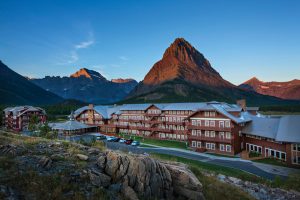
The Many Glacier Hotel after the completion of the renovation in 2017. Courtesy of Mark Bryant Photographics.
Through innovative structural solutions that preserved the historic fabric of the building, the Many Glacier Hotel now complies with current building codes, and visitors can experience the structure’s original charm and grandeur for years to come.■

